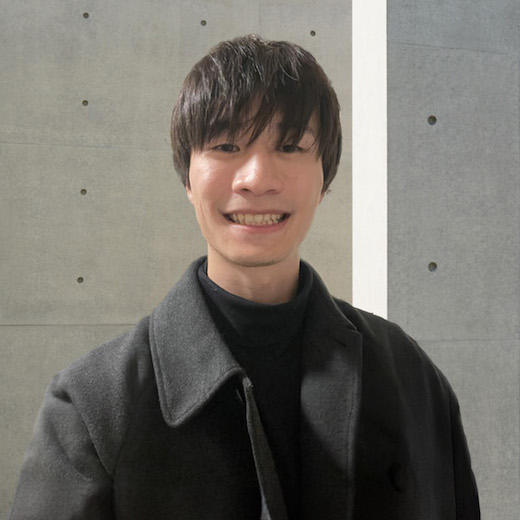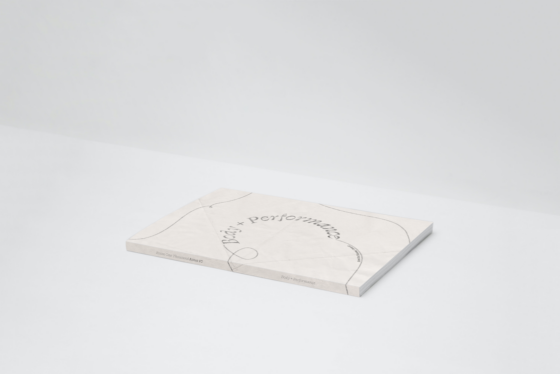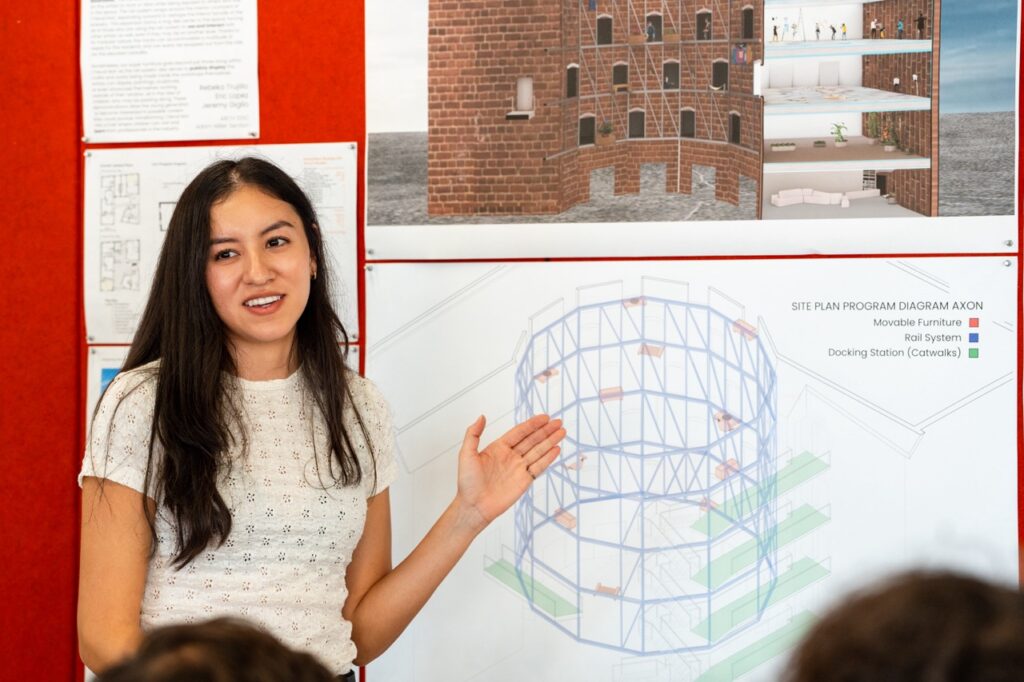Master of Architecture (MArch)
Renowned for its history of design excellence, Berkeley’s MArch program grounds you in the fundamentals of architectural design through a rigorous sequence of studios and supporting courses where you will engage with architecture as a conceptual and meaningful discipline aimed at synthesizing space, form, and material. Our award-winning multidisciplinary faculty introduce you to a variety of approaches to architectural design, representation, and research.
By your final year, you’ll be prepared to apply your cumulative knowledge and distinct architectural voice to your own directed thesis project. You’ll graduate with the passion and skills to discover, critically assess, and create — to push the discipline forward to meet the promises and challenges of the 21st century.

ABOUT THE PROGRAM
Berkeley’s Master of Architecture is centered around the design studio and enriched by courses in building science and technology, sustainability and history, theory, and society. As an MArch student, you’ll work closely with your classmates and professors in our light-filled open-plan studio to develop and represent your design ideas. You’re encouraged to identify your own creative and research passions, with the support of your instructors and peers.
Design is the core of the curriculum, and students enroll in an architectural design studio each semester. Working collaboratively with your cohort in design studios, you’ll learn how to create architecture that serves both communities and the environment over the long term.
We offer two tracks leading to the MArch degree, a two-year track and a three-year track, depending on your previous educational experience and the recommendation of the admissions committee.
The MArch program is for those seeking their first accredited professional degree in Architecture. If you hold a five-year professional bachelor of architecture degree from a NAAB-accredited school or a comparable five-year degree from a foreign university or technical institute, you may be eligible to apply for our one-year post-professional Master of Advanced Architectural Design (MAAD).
Berkeley’s MArch is a full-time residential degree program accredited by the National Architectural Accrediting Board (NAAB) and designated as a STEM degree by the U.S. Department of Homeland Security. Learn more about NAAB accreditation.

“Through UC Berkeley’s MArch program, I learned to design with a profound focus on humanistic sensitivity, emphasizing responsible building practices and creating spaces that harmonize with both natural ecosystems and diverse social contexts.” — Jack Tam, MArch 2024
WHY BERKELEY

The Department of Architecture offers you a rich intellectual community rooted in the dynamic contexts of UC Berkeley, the Bay Area, and California. As a graduate student at the nation’s top public research university, you’ll be part of a diverse community of changemakers known worldwide for innovation and academic excellence. Our passion for critical inquiry, debate, and creative experimentation is informed by a deep commitment to social equity and climate solutions.
The Bay Area led the movement to reshape architecture through a humanistic lens and today it’s home to some of the profession’s most innovative designers.
California, the birthplace of the environmental movement and social justice advocacy, is at leading edge of making our cities more just and climate resilient. The state’s diverse population, 40 million strong, and its rich and varied conditions make it the ideal laboratory for our discipline.
About the College of Environmental Design
The Department of Architecture, established at UC Berkeley in 1903, was one of the founding departments in the College of Environmental Design. When the college was created in 1959, it was the first in the nation to unite the disciplines of architecture, planning, and landscape architecture, leading the way toward an integrated approach to analyzing, understanding, and designing our built environment. The college emphasizes environmental design as a profoundly ethical practice, inseparable from social, political, economic, and cultural contexts and co-produced through dynamic engagements with diverse communities.
Principles of Community
The College of Environmental Design is committed to building an inclusive environment for our faculty, students and staff that respects and reflects the diverse communities in which we live and work. We use design, research and teaching as drivers of change toward equitable futures.
OUR FACULTY

Our multidisciplinary faculty have expertise in design, building science and technology, and history and theory of architecture. As an MArch student, you also have opportunities to study with experienced local practitioners who teach regularly in the program, as well as distinguished visiting faculty from around the world.
- Faculty Specializations
- Engaged architectural practice
- Political/social content of design artifacts
- Design for climate
- Building performance
- Situated urbanism
- Virtual reality
- Material innovation
- Robotic manufacturing
- Generative AI and machine learning
- Parametric design
- Emerging timber technologies
Graduate Student Journal

Room One Thousand is the graduate architecture journal at UC Berkeley’s College of Environmental Design. Perched atop Wurster Hall, Room 1000 is also a small, unemphasized room with expansive views of Berkeley, the San Francisco Bay, and the ocean beyond.
Like its namesake, the journal serves as a vantage point from which one might observe contemporary architecture as it operates in relation to the city, the landscape, and the many forces, institutions, and people that help shape them. The journal is thought of as a medium: as both a platform for conversation and a vehicle for generation.
Degree Tracks
Both the two-year and three-year MArch degree tracks lead to a NAAB-accredited MArch degree that prepares you for the practice of architecture and meets the education requirement for pursuing your architecture license.
The curriculum of both tracks is organized around the core design studio, which is the setting for the synthesis and integration of technical, environmental, historical, and theoretical course offerings. Students in the three-year track will take 6 studios, and students in the two-year track will take 4 studios.
In your first year of the three-year track is focused on the development of architectural design and representational skills. The second year of the three-year track and the first year of the two-year track focus on architecture + urbanism in the fall semester. The option studio in the spring semester of this year is taught by visiting professors from around the world, and has a studio travel component.
In your final year, you will get to apply your knowledge in an integrated studio in the fall and create your own thesis project in the spring. The spring thesis studio also has a required research seminar component in the fall.
MArch: The three-year degree track
The three-year MArch is open to students with undergraduate degrees in any discipline. Applicants with an undergraduate degree in architecture and 4 or fewer weighted architecture design studios may only be considered for this track.
Students in the three-year track will join the incoming cohort of students in the two-year track in the fall semester of your second year.
- Plan of Study
YEAR 1
FALL
- ARCH 200A: Introduction to Architecture Studio 1 (6 units)
- ARCH 200C: Representational Practices in Architectural Design 1 (3 units)
- ARCH 207A: Ced Lectures Colloquium (1 unit)
- ARCH 270: History of Modern Architecture (3 units)
SPRING
- ARCH 200B: Introduction to Architecture Studio 2 (6 units)
- ARCH 200D: Representational Practices in Architectural Design 2 (2 units)
- ARCH 230: Advanced Architectural Design Theory + Criticism* (3 units)
- ARCH 250: Introduction To Structures* (3 units)
YEAR 2
FALL
- ARCH 201: Architecture + Urbanism Studio (6 units)
- ARCH 207B: Architecture + Urbanism Colloquium (1 unit)
- ARCH 207D: The Cultures of Practice (3 units)
- ARCH 260: Introduction to Construction* (3 units)
SPRING
- ARCH 202: Graduate Option Studio (6 units)
- ARCH 240: Advanced Study of Energy + Environment* (3 units)
- Elective
YEAR 3
FALL
- ARCH 203: Integrated Design Studio (6 units)
- ARCH 207C: Professional Practice Colloquium (1 unit)
- ARCH 204A: Final Thesis Seminar (3 units)
- Elective
SPRING
- ARCH 204B: Final Thesis Studio (6 units)
- Elective
- Elective
72 TOTAL UNITS
Total Graduate Credit Hours will vary per student.
*Course substitution requests for this requirement may be submitted at the beginning of the Fall semester of your first year of enrollment. If a required course is approved for substitution, you must take an advanced course in the same area prior to graduation.
MArch with advanced standing: The two-year degree track
Those with an exceptional undergraduate record and at least 5 weighted studios in a focused pre-professional degree in architecture, such as a BA or BS with a major in architecture, qualify to be considered for advanced standing (two-year MArch). Placement in advanced standing is at the discretion of the admissions committee.
- Plan of Study
YEAR 1
FALL
- ARCH 201: Architecture + Urbanism Studio (6 units)
- ARCH 207B: Architecture + Urbanism Colloquium (1 unit)
- ARCH 260: Introduction To Construction* (3 units)
- ARCH 270: History Of Modern Architecture (3 units)
SPRING
- ARCH 202: Graduate Option Studio (6 units)
- ARCH 230: Advanced Architectural Design Theory + Criticism* (3 units)
- ARCH 240: Advanced Study Of Energy + Environment* (3 units)
- ARCH 250: Introduction To Structures* (3 units)
YEAR 2
FALL
- ARCH 203: Integrated Design Studio (6 units)
- ARCH 207C: Professional Practice Colloquium (1 unit)
- ARCH 204A: Final Thesis Seminar (3 units)
- ARCH 207D: The Cultures Of Practice (3 units)
SPRING
- ARCH 204B: Final Thesis Studio (6 units)
- Elective
- Elective
52 TOTAL UNITS
Total Graduate Credit Hours will vary per student.
*Course substitution requests for this requirement may be submitted at the beginning of the fall semester of your first year of enrollment. If a required course is approved for substitution, you must take an advanced course in the same area prior to graduation.
Thesis Projects

The opportunity to complete a thesis project in as little as two years of study differentiates Berkeley MArch from other programs.
Selected recent MArch thesis topics:
- Transitional housing typologies
- Warehouse adaptive reuse
- Circular architecture
- Flood resilience
- Redefining the concept of home
- Spatial experiences for the visually impaired
- The future of vacant office buildings
- Renewable energy communities

“I chose Berkeley for its reputation for design excellence and commitment to social justice, but what I came to value most was the supportive and collaborative studio culture” — Al Oliva, MArch 2024
CONCURRENT DEGREES
At CED, you can expand your course of study by earning a concurrent degree in landscape architecture or city planning.
FINANCING YOUR EDUCATION
We are committed to recruiting students of outstanding achievement and potential, regardless of ability to pay.
In addition to tuition, UC Berkeley students pay several types of fees, including a campus fee, student services fee, and others. Students enrolled in professional degree programs, including the MArch, are also charged Professional Degree Supplemental Tuition (PDST). Find current tuition and fee information on the Office of the Registrar website.
The Department of Architecture awards a limited number of graduate fellowships each year to incoming students.
- Fellowships are awarded to incoming MArch students by the Department of Architecture based on merit, need, and/or diversity.
- Departmental fellowships for incoming MArch students typically cover some part of tuition or fees for the first year. A few multiyear awards are allocated each year to those with exceptionally strong applications and/or significant financial need.
If you plan to pursue social impact work after earning your degree, we encourage you to apply for the Arcus Social Justice Corps Fellowship, which provides full funding so you can graduate debt-free. (Please note that the Arcus Fellowship is available only to domestic students.) We also encourage you to apply to competitive university fellowships.
Find more information about financial aid, fellowships, student employment, and reporting requirements on CED’s Fees + Financial Aid web page.
Internships + Careers
All of our students have access to one-on-one counseling offered by the College of Environmental career advisor, as well as UC Berkeley’s robust career services, for up to two years after graduation.
The depth and reach of our pedagogy well prepares you to join architectural design firms, as well as to hold teaching positions at leading institutions around the world. Our graduates are prepared to serve as national and international architectural design leaders, building thriving communities in a world of rapid political, economic, and environmental change.
HOW TO APPLY
UC Berkeley begins accepting applications in early September for the following fall term only (no spring admissions). The fall semester begins in mid-August.
We recommend you start the application process as soon as possible. As a prospective graduate student, you’ll submit your application through UC Berkeley’s Graduate Division. You’ll find lots of useful information on the Graduate Division website, including application instructions and information about funding your education.
- Review university admissions requirements on the Graduate Division website and program admissions requirements below
- Gather materials:
- Unofficial transcripts for each prior college or university attended
- Statement of Purpose. Please respond to the prompt included below and on the Architecture Program Page portion of the application. For general tips on writing the Statement of Purpose, please see Writing the Statement of Purpose on the UC Berkeley Graduate Division website.
- Personal Statement. Please respond to the prompt included below and on the Architecture Program Page portion of the application. For general tips on writing a Personal History Statement, please see the Personal Statement Guide on the UC Berkeley Graduate Division website.
- Contact information for three recommenders
- Resume/CV
- Evidence of English language proficiency, if applicable. For waiver eligibility, visit the Graduate Division website. Please note, Architecture requires a TOEFL score of 100. Our IELTS score requirement is the same as the Graduate Division’s
- Portfolio
- Information about studio coursework
- List of relevant publications or presentations
- List of honors/awards
- URL of website where your work is published, if applicable
- Start your application on the Graduate Division website. You do not have to complete the entire application at one time: we recommend you start your application and review it as soon as possible.
- Scroll down and select Architecture MArch.
- Follow the instructions in the application. See below for MArch-specific instructions and specifications for supplemental materials.
- Pay the application fee. Please note that only domestic applicants are eligible to apply for a Graduate Division fee waiver. The Department of Architecture is not able to offer fee waivers.
- Submit application. Allow yourself at least one hour prior to the deadline to submit your application. Late applications or changes to the application after the deadline will NOT be accepted.
- After submitting your application, you will receive an email from UC Berkeley’s Graduate Admissions Office confirming your submission.
- We strongly encourage you to log back into your application to monitor the status of materials received/processed, such as fee waivers, test scores, and recommendations.
- We send admissions decisions, along with notification of fellowship awards, in mid to late March.
Only online applications (including letters of recommendation) are accepted. All documents, regardless of language of instruction, must be translated into the English language. Transcripts, diplomas, and certificates should be provided in the original language of instruction AND in English. Transcripts must show your full name, degree conferral date, and degree.
Questions?
Contact archgradadm@berkeley.edu.
MArch-Specific Instructions
- Statement of Purpose + Personal History Statement
- Portfolio
- Prerequesites
- Admissions Criteria
- Admissions Process
- Committee
Statement of Purpose (500 word max)
Please share your analysis of an aspect of the built environment (architecture, building, urban space, architect, architectural movement, theoretical or historic argument, piece of architecture historical writing, etc.), either authored or vernacular, that has had an impact on your decision to pursue a graduate education in architecture.
Concurrent applicants: Please submit a Statement of Purpose that follows the program’s guidelines for each program you are applying for.
Personal History Statement (500 word max)
What does your application not say about you? Please elaborate on a specific experience that has shaped your decision to pursue architecture.
Concurrent applicants: Please submit a Personal History Statement that follows the program’s guidelines for each program you are applying for.
The purpose of the portfolio is to demonstrate a your creative ability and design sensibility.
The portfolio should demonstrate your capacity for design thinking, sensibility toward design execution, and the ability to carry through an idea, showing design synthesis that goes beyond the aggregation of discrete elements. Your portfolio will be reviewed as a whole, and should represent your work in the best possible light.
Any material that is not entirely your own work must be clearly identified. This includes identifying the your role and contribution in any group work, and identifying the use of AI to generate any written or visual content.
If you wish to be considered for advanced standing (two-year MArch), your portfolio must include a clear presentation of your knowledge of current design practice in architecture. This should be demonstrated within comprehensive sets of drawings and models showing understanding of architectural processes and conventions. It must include projects completed as part of studio courses. Independent work done outside of this context must include information about the project.
Your portfolio should enable reviewers to evaluate your grasp of tools that express these architectural conventions, including, but not limited to, two-dimensional orthographic drawings such as plans, sections, and elevations, and three-dimensional representations such as axonometrics and obliques. Physical models, renderings, and other media formats are also encouraged, but the absence of architectural drawings will be taken into account when the admissions committee determines if an applicant will be evaluated for advanced standing (two-year MArch).
If you do not have academic or professional training in architecture, you may submit work that shows other evidence of creativity (studio art, hand drawing, furniture or installation design, fabrication and construction craft, etc.) and clearly demonstrates interest in the proposed subject field. If architectural design projects are included in the portfolio, you should include an explanation of how you completed the project (training, project brief, etc).
There are no specific restrictions on formatting, file size, number of projects, or number of pages, but the document must be a single pdf. We recommend portfolios not be too large (approximately 10 MB and 20 pages) with image and drawing quality and legibility maintained. Any dimensions may be used for the portfolio, which can be formatted either in single pages or two-page spreads, but please keep in mind that review will take place on monitors of varying size.
Please see Graduate Division’s admissions requirements for university-wide requirements.
The following are MArch prerequisites:
- For those without an undergraduate degree in architecture: completion of college-level or equivalent calculus and introductory physics, including mechanics (by the time of admission, NOT at the time of application). Must pass course with a grade of at least C minus.
- For those who have taken Advanced Placement (AP) calculus or physics in high school, the following scores will satisfy the prerequisites: 5 on the AP Calculus AB exam or 3 on the AP Calculus BC exam; at least a 3 on the AP Physics B exam.
The Department of Architecture welcomes applications from students with a range of academic and personal backgrounds. Each application is viewed holistically by multiple admissions committee members.
Applicants to the Master of Architecture are evaluated in three main areas:
1. Statement and letter. We are looking for evidence of diverse experiences, commitment to the discipline, and potential for leadership.
2. Academic record. We use this to evaluate curricular choices, scholastic achievement, and potential to succeed in required coursework.
3. Portfolio. See section above.
For more information on the UC Berkeley diversity policy, please see the Graduate Division website.
First phase: Two Berkeley Architecture instructors read each application. Using the criteria listed above, they rank them from 1 (weak) to 5 (strong) and make a recommendation to either admit/review/deny.
Second phase: The MArch Admissions Committee members each review a portion of the applicant pool using the criteria listed above and rank them from 1 (weak) to 5 (strong) and make a recommendation to either admit/review/deny.
Third phase: The MArch Admissions Committee collectively reviews the applicants that move forward (approximately 50%) and decides who will be admitted and into which degree track. Again, applications are reviewed in the three areas above and in relation to all the top-ranked applicants to make the final admission decisions. The committee also considers each applicant’s background and the strengths they can contribute to their entering class. This process allows students with varied backgrounds and emphases into the program to support and maintain the different areas of interests we provide.
The Admissions Committee is composed of members of the MArch Committee and the department chair. It is a standing committee of approximately four to five members appointed by the department chair each year.
FAQ
Eligibility
- Am I eligible for the MArch program?
- Can I transfer from another master’s program?
- Am I eligible for the MArch with advanced standing (two-year professional program)?
The following are prerequisites for the MArch Program:
- REQUIRED Bachelor’s degree or recognized equivalent from an accredited institution
- REQUIRED Grade point average (GPA) of 3.0 or better (on a 4-point scale) in the last two years of undergraduate study (also known as your advanced GPA).
- Please calculate your GPA.
- Note that we do not require an uploaded GPA calculation worksheet.
- For those applicants whose undergraduate university does NOT use a 4-point scale, the calculation of an advanced GPA is NOT required. If this applies to your previous institution(s), please enter “N/A” in the GPA section.
- REQUIRED For those applying without an undergraduate degree in Architecture: completion of college-level or equivalent calculus and introductory physics, including mechanics (by the time of admission); Must pass course with a grade of at least C minus.
For those who have taken Advanced Placement (AP) Calculus or Physics in high school, the following scores will satisfy the prerequisites: 5 on the AP Calculus AB exam or at least a 3 on the AP Calculus BC exam; at least a 3 on the AP Physics B exam.
Physics + Calculus Requirements
- The requirement would need to be satisfied prior to the start of the fall semester.
- You may take a course from any accredited university or community college.
Physics courses must include topics of mechanics. If you are unsure you may send your syllabi via email to check. - If you plan to take the course at a California Community College, please consult assist.org in order to verify the course will satisfy the requirement.
- Third-the party vendor courses are not accepted (straighterline, chegg, coursera, etc).
- AP credit is accepted with an exam score of 4 or higher.
Official policy is that we are unable to accept transfer units for our MArch program. You may join our program as a new student however you would be required to complete the full number of units required for the program. Note regarding transferral of units: Accepted students may apply to waive courses already taken in undergraduate program. Waived courses must be replaced with advanced/alternative level of the same course. For example: if a student waives Introduction to structures, they must enroll in advanced structures.
Advanced standing is awarded at the discretion of the admissions committee during the time of application review. The admissions committee will determine advanced standing individually for each student during the admissions review. Please note that there is only one application for the MArch two- and three-year programs.
Program Details
- Which programs are STEM designated?
- How many students are typically accepted into the MArch programs?
- Which architecture program is best suited for me?
- What is the MArch waiver and course substitution process?
The following programs are STEM designated:
MAAD (one-year post-professional Master of Advanced Architectural Design)
MArch with advanced standing (two-year professional program)
MArch (three-year professional program)
Concurrent Master of Architecture and Master of Landscape Architecture
Concurrent Master of Architecture and Master of City Planning
Concurrent Master of Architecture and Master of Science in Engineering
On average, the Department of Architecture accepts 45 students for the two-year MArch with advanced standing and 45 students for the three-year MArch each year.
The MArch program is for those seeking their first accredited professional degree in architecture and who hold a pre-professional degree in architecture or another undergraduate degree in any discipline,
If you hold a five-year professional bachelor of architecture degree from a NAAB-accredited school or a comparable five-year degree from a foreign university or technical institute, you are best suited for our one-year post-professional Master of Advanced Architectural Design (MAAD) program.
All incoming students will receive a Google form to submit their course waiver requests for ALL required courses. The form will be due by the first day of instruction. Instructors will review each request and you will be notified of decisions. If approved, you will need to replace substituted courses with an advanced level of the same course.
Advanced Course Options (MArch 2-Year)
- If waived out of ARCH 230, you must take an advanced course in design theory and criticism, numbered ARCH 23X, for three or more units.
- If waived out of ARCH 240, you must take an advanced course in energy and environment, numbered ARCH 24X, for two or more units.
- If waived out of ARCH 250, you must take an advanced course in structures, numbered ARCH 25X, for three or more units
- If waived out of ARCH 260, you are required to take an advanced course in construction, numbered ARCH 26X, for three or more units.
- If waived out of ARCH 270, you must take an advanced course in history, numbered ARCH 27X, for three or more units.
Advanced Course Options (MArch 3-Year)
- If waived out of ARCH 230, you must take an advanced course in design theory and criticism, numbered ARCH 23X, for three or more units.
- If waived out of ARCH 240, you must take an advanced course in energy and environment, numbered ARCH 24X, for two or more units.
- If waived out of ARCH 250, you must take an advanced course in structures, numbered ARCH 25X, for three or more units
- If waived out of ARCH 260, you are required to take an advanced course in construction, numbered ARCH 26X, for three or more units.